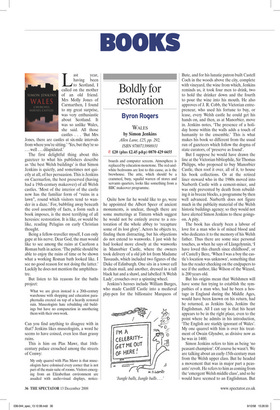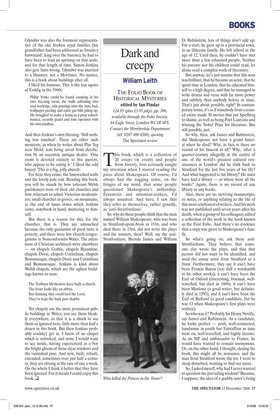BOOKS
Last year, having been to Scotland, I called on the mother of an old friend.
Mrs Molly Jones of Carmarthen, I found to my great surprise, was very enthusiastic about Scotland. It was so unlike Wales, she said. All those castles . . . ‘But Mrs Jones, there are castles at six-mile intervals from where you’re sitting.’ ‘Yes, but they’re so . . . well . . . dilapidated.’ The first delightful thing about this gazeteer to what his publishers describe as ‘the best Welsh buildings’ is that Simon Jenkins is quietly, and sometimes not qui etly at all, of her persuasion. This is Jenkins on Caernarfon, the best preserved (having had a 19th-century makeover) of all Welsh castles. ‘Most of the interior of the castle now has the familiar form of “ruins in a lawn”, round which visitors tend to wan der in a daze.’ For, bubbling away beneath the cool assembly of facts, a form such a book imposes, is the most terrifying of all heresies: restoration. It is like, or would be like, reading Pelagius on early Christian thought.
Being a fellow-traveller myself, I can only gape at his nerve. Dear God, the man would like to see among the ruins at Caerleon a Roman bath in action. ‘The public should be able to enjoy the ruins of time or be shown what a working Roman bath looked like. I see no good reason for not doing the latter.’ Luckily he does not mention the amphitheatre.
But listen to his reasons for the baths project:
What we are given instead is a 20th-century warehouse with shopping and education paraphernalia erected on top of a heavily restored ruin. Museologists hate rebuilding old buildings but have no compunction in smothering them with their own work.
Can you find anything to disagree with in that? Jenkins likes museologists, a word he seems to have coined, even less than grassy ruins.
This is him on Plas Mawr, that 16thcentury palace crouched among the streets of Conwy:
My only quarrel with Plas Mawr is that museologists have colonised every corner that is not part of the main suite of rooms. Visitors emerging from an Elizabethan environment are assailed with audio-visual displays, notice
Quite how far he would like to go, were he appointed the Albert Speer of ancient monuments, is unclear, though there are some mutterings at Tintern which suggest he would not be entirely averse to a restoration of the whole abbey to ‘recapture some of its lost glory’. Actors he objects to, finding them distracting, but his objections do not extend to waxworks. I just wish he had looked more closely at the waxworks in Manorbier Castle, where the owners took delivery of a old job lot from Madame Tussauds, which included two figures of the Duke of Edinburgh. One sits in a tower cell in chain mail, and another, dressed in a tall black hat and a shawl, and labelled ‘A Welsh Lady’, crouches over a spinning wheel.
Jenkins’s heroes include William Burges, who made Cardiff Castle into a medieval play-pen for the billionaire Marquess of Bute, and for his lunatic patron built Castell Coch in the woods above the city, complete with vineyard, the wine from which, Jenkins reminds us, it took four men to drink, two to hold the drinker down and the fourth to pour the wine into his mouth. He also approves of J. R. Cobb, the Victorian entrepreneur, who used his fortune to buy, or lease, every Welsh castle he could get his hands on, and then, as at Manorbier, move in. Jenkins notes, ‘The presence of a holiday home within the walls adds a touch of humanity to the ensemble.’ This is what makes his book so different from the usual run of gazeteers which follow the dogma of state curators, of ‘preserve as found’.
But I suppose he would have drawn the line at the Victorian bibliophile, Sir Thomas Philipps, who proposed to buy Manorbier Castle, then roof it over, all of it, to house his book collections. Or at the retired liner steward who in the 1980s moved into Narberth Castle with a cement-mixer, and was only prevented by death from rebuilding it in breeze blocks, a programme by then well advanced. Narberth does not figure much in the publicity material of the Welsh historic buildings agency; so they would not have alerted Simon Jenkins to these goingson. A pity.
The book has clearly been a labour of love for a man who is of mixed blood and who dedicates it to the memory of his Welsh father. Thus there are some nice personal touches, as when he says of Llangelynnin, ‘I have loved this church since childhood’, or of Castell y Bere, ‘When I was a boy the castle’s location was unknown’, something that has the reader checking on the endpapers to see if the author, like Wilson of the Wizard, is 200 years old.
But his origins mean that Welshmen will have some fun trying to establish the sympathies of a man who, had he been a hostage in England during the Middle Ages, would have been known on his return, had he returned, as Jenkins Sais, Jenkins the Englishman. All I can say is that his heart appears to be in the right place, even to the point where he admits in his introduction, ‘The English are starkly ignorant of Wales’. My one quarrel with him is over his treatment of Owain Glyndwr, as divisive now as he was in 1400.
Simon Jenkins refers to him as being ‘no peasant champion’. Of course he wasn’t. We are talking about an early-15th-century man from the Welsh upper class. But he headed a movement that was in major part a peasants’ revolt. He refers to him as coming from the ‘emergent Welsh middle class’, and so he would have seemed to an Englishman. But Glyndwr was also the foremost representative of the old, broken royal families (his grandfather had been addressed as ‘brenin y barwniaid’, king over the barons); he had to have been to lead an uprising on that scale, and for that length of time. Simon Jenkins also gets facts wrong. Glyndwr was married to a Hanmer, not a Mortimer. No matter, this is a book about buildings after all.
I liked his humour. This is the last squire of Erddig in the 1960s:
Philip Yorke could be found camping in his own freezing room, the walls subsiding into coal workings, rain pouring onto the state bed, wallpaper peeling and calor gas bills piling up. He struggled to make a living as a prep schoolmaster, security guard and tour operator with his own minibus.
And then Jenkins’s own blessing. ‘Still nothing was touched’. There are other such moments, as when he writes about Plas Teg near Mold, now being saved from dereliction by an eccentric antique dealer: ‘One room is devoted entirely to live parrots, who appear to be eating it.’ I liked the odd breezy ‘This is a big, jolly church’.
For here they come, the limewashed walls and the lovely pale oak. Reading this book, you will be struck by how tolerant Welsh parishoners were of their old churches and how reluctant to admit Victorian modernisers; small churches in groves, on mountains, at the end of lanes down which Jenkins came, notebook in hand, muttering to himself.
But there is a reason for this, for the churches, that is. They are untouched because the only guarantor of good taste is poverty, and there were few church congregations in Nonconformist Wales. The attentions of Christian architects were elsewhere — on chapels Gothic, chapels Byzantine, chapels Doric, chapels Corinthian, chapels Romanesque, chapels Doric and Corinthian and Romanesque. Jenkins is kind about Welsh chapels, which are the ugliest buildings known to man:
The Trellwyn Methodists have built a church. The front looks like an abbey, But thinking they could fool the Lord, They’ve kept the back part shabby.
Yet chapels are the most prominent public buildings in Wales; you see them bleakly everywhere, so that it is a shock to see them so ignored here, little more than half a dozen in this book. But then Jenkins probably couldn’t get in. I know of no chapel which is unlocked, and none I would want to see inside, having experienced as a boy the bright gloom of those clear windows and the varnished pine. And now, built, rebuilt, extended, sometimes over just half a century, they are closing at the rate of one a week. On the whole I think it better that they have been ignored. For it meant I could enjoy this book. ❑











































































 Previous page
Previous page